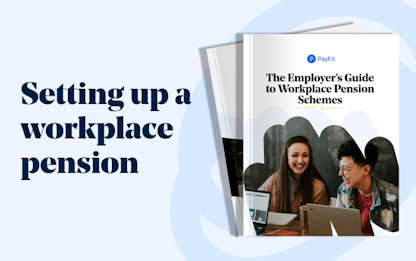- Blog
- |People management
- >Pensions
- >re-enrolment
All You Need to Know About Re-Enrolment in the UK


You’ve enrolled your staff into a workplace pension scheme, you’re paying the correct amounts into it and so that’s one less thing to worry about, right? Well, not exactly. If a member of staff has, for whatever reason, left the pension scheme - for example if they’ve opted out or reduced their contributions - you’re legally obliged to re-enrol them and re-declare your compliance to The Pensions Regulator.
Read our guide to re-enrolment below.
What is re-enrolment, and what does it mean for UK employers?
Re-enrolment, sometimes referred to as cyclical re-enrolment, is the process by which employers re-enrol employees who have left the company pension scheme. It’s a legal obligation for all UK employers, and happens every 3 years.
If you’re carrying out the process for the first time, then the recommended pension re-enrolment date is the third anniversary of your staging date. In other words, the date when your automatic enrolment duties came into force for your business (i.e.: the day your first member of staff started working for you).
As part of the process, employers must:
choose a re-enrolment date (more on this below);
identify eligible staff, re-enrol them with effect from their re-enrolment date and start contributing to their pension scheme from this date;
write a re-enrolment letter to employees concerned within 6 weeks of their pension re-enrolment date, notifying them that they have been re-enrolled;
complete a new (re)-declaration of compliance within 5 calendar months of the third anniversary of your staging date;
ensure the contact details for the individual(s) overseeing the process are up to date, so that The Pensions Regulator can send them more information regarding future re-enrolment duties.
It’s worth noting that if you have assessed your staff and nobody needs to be re-enrolled, you only need to complete the re-declaration of compliance from the steps above. You also don’t need to inform the Regulator of your chosen date until you’ve completed your re-declaration of compliance.
And unlike with the initial auto enrolment process, you cannot use postponement.
How to choose a re-enrolment date
As mentioned above, your re-enrolment date tends to be 3 years after your staging date (or ‘duties start date’ if the company was established after October 2017), but you do have some flexibility around this. That is to say, 3 months before the anniversary date, and 3 months after, meaning that you have a 6 month window in total.
The re-enrolment date should be the same for all staff that need to be re-enrolled.
This is also the case if there is more than one payroll cycle running within the business. So if you have a monthly and weekly pay date for different employees, you must use the same re-enrolment date for both.
If you run payroll for 2 companies under the same PAYE scheme, such as a director payroll and standard payroll, you’ll need to process re-enrolment at the same time for both. But if the companies are under 2 separate PAYE schemes, the re-enrolment date can be different.

How should staff be handled on the pension re-enrolment date?
All staff should be treated the same when being re-enrolled. In other words, if they have opted out of the pension scheme or have reduced their contributions, they should be re-enrolled if they still meet the criteria. This means that they need to be aged between 22 and the State Pension age and earn over £10,000 a year (and bear in mind that there are different thresholds for each pay frequency).
As mentioned above, employees should be contacted within 6 weeks of the pension re-enrolment date.
It may be the case that you’re assessing staff who have never been automatically enrolled before, at the same time as re-enrolling those who have. Postponement can be used for staff who become eligible for the very first time, for example if they have turned 22 or gotten a pay rise above the earnings trigger, but it cannot be used for the staff being re-enrolled.
Are there any exceptions to the re-enrolment rule?
If employees are already in the pension scheme (and therefore don’t need to be re-enrolled), are meeting the minimum contribution levels, have been given or handed in their notice, then the cyclical re-enrolment process is not required for them. As an example, an employee might drop down their contribution rate, but stay in the scheme nonetheless. Re-enrolment reverts them back to paying the minimum contribution rates required for automatic enrolment.
Additionally, directors in an LLP where neither has an employment contract, or a sole director (with or without an employment contract), with no other employees, are exempt. For companies with more than one person, as soon as they sign an employment contract, they’re no longer exempt.
What happens after the process has completed?
Once the process detailed above has been completed, any employee can opt out of the pension again, or just continue contributing (and having the company contribute additionally) towards the scheme.
While the process happens every 3 years, the actual date is only based on the 3rd anniversary of your staging date the first time you go through the process. Fast forward another 3 years, and then for all subsequent re-enrolments, the re-enrolment date will be based around the 3rd anniversary of the previous date.
The whole process is simplified significantly when using PayFit. For non-users looking to learn more about how we facilitate a smooth payroll process each and every month, why not book in a call with one of our product specialists below?


The 2024 UK National Living Wage - An Employer’s Guide

The Cost Of Recruitment In The UK - What You Might Not Know

UK National Insurance Changes for January 2024

End Of Tax Year 2023/2024 - Eight Key Changes For 24/25

Strategies to Reduce Employee Turnover

